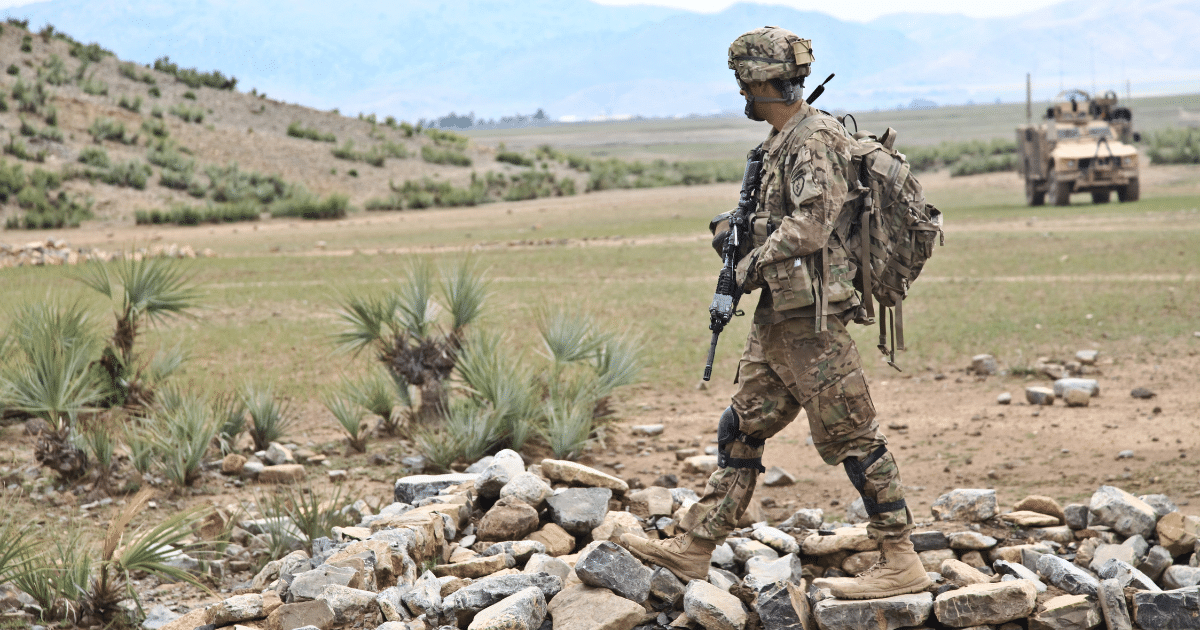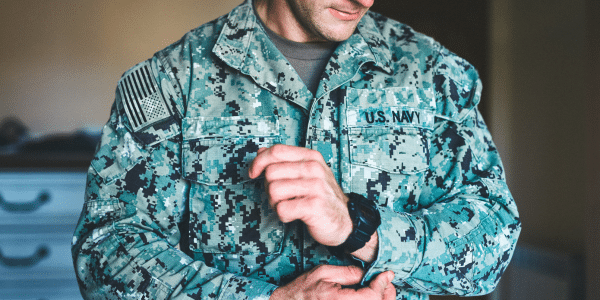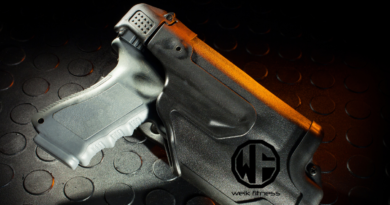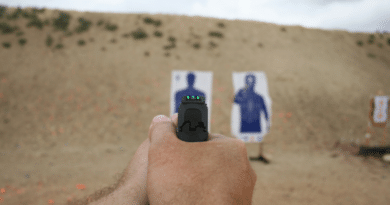The History of Military Camo Patterns
For any prepper or survivalist, the key to staying unseen can often mean the difference between success and failure in the wild. The art of blending seamlessly into your surroundings is where military camo patterns come into play.
These intricate designs are more than just fashion; they’re about survival, concealment, and gaining that all-important edge in various terrains.
Did you know that camouflage has been helping soldiers stay hidden since World War I? It’s a game of visual deception that has evolved enormously over the past century. In this post, we’ll dive into the fascinating progression of military camo patterns, explore their types influenced by diverse environments, and even see how they’ve made their way into civilian life as popular gear for hunters and outdoor enthusiasts alike.
Ready for a covert journey through history? Keep reading to uncover the secrets behind these mysterious patterns!
Key Takeaways
- Camouflage techniques have evolved drastically since World War I, when the French army first introduced patterned uniforms. The purpose of these patterns is to conceal military personnel by disrupting their silhouette and blending them into various environments.
- There are several types of camo patterns, including traditional designs that mimic natural surroundings like forests or grasslands, abstract digital and pixelated patterns suitable for multiple terrains, and hybrid camos combining both elements.
- Environment plays a significant role in the design of military camouflage; different terrains such as woodland, desert, urban areas, arctic zones, maritime settings, and mountainous regions require unique color schemes and pattern styles for effective concealment.
- Popular civilian camouflage brands like Mossy Oak, Realtree, and Kryptek offer specialized patterns for hunters and outdoor enthusiasts that are designed to blend into specific natural landscapes for optimal stealth.
- Advancements in military camo technology continue with new innovations aimed at enhancing invisibility against modern detection methods, including infrared surveillance. This includes the development of materials that adjust colors based on surroundings and lightweight yet durable fabrics.

Table of contents
Evolution of Military Camo Patterns: The Type of Camo Mattered
The evolution of military camo patterns has been driven by the need for effective concealment in combat. Whether a marine in the USMC, an army ranger in the US Army, US Special Forces, or any rank in the military, the camo patterns on a combat uniform meant something. From early forms of camo to the development of more intricate and specialized patterns, this evolution reflects the changing nature of warfare and advancements in technology.
Purpose of camouflage in the military
Camouflage patterns used in the military serve a critical purpose: they make soldiers and their equipment harder to detect by the enemy. The most commonly seen available today is the multicam pattern. Blending into various environments through different patterns, whether it’s woodland, arid fields, or jungles, gives troops a significant tactical advantage during combat operations.
This strategic use of colors and patterns can save lives by concealing troops from opponents both on foot and in aerial reconnaissance.
Imagine clothing and gear that mimic natural surroundings so closely they essentially become invisible; that’s what effective military camouflage achieves. It disrupts the human silhouette, breaking up outlines that would otherwise be visible against contrasting backgrounds.
From sniper ghillie suits to vehicles draped in camo nets, this art of disguise keeps forces one step ahead, ensuring stealth movements and successful missions without tipping off adversaries about their presence or intentions.
Early forms of camo design
Military camouflage has come a long way since the 18th century when rifle units used simple tactics such as mud smearing on uniforms to blend in with their surroundings. By World War I, armies realized the significant advantage that camo offered on the battlefield.
The French army took a major leap forward by incorporating it into their strategies and gear, thanks to innovative thinkers like Lucien-Victor Guirand de Scévola. This early form of camouflage was not just about dull colors; artists played a key role in designing complex patterns that mimicked natural landscapes.
During World War I, ships at sea also sported disruptive patterns known as “Dazzle,” which confused enemy submarines trying to gauge the vessel’s speed and direction. While these early forms of camo were rudimentary compared to modern standards, they marked an important milestone in military tactic evolution.
These initial steps paved the way for an array of specialized patterns, such as tigerstripe and lizard patterns, specifically tailored for various combat environments—forests, deserts, mountains—and helped soldiers stay concealed from opposition forces effectively.
Development of more effective camouflage patterns
Military forces constantly innovate to stay ahead, and the development of more effective camouflage patterns is no exception. In response to varying combat environments and technological advancements, these patterns have become increasingly sophisticated.
Traditional designs gave way to intricate digital patterns that break up a soldier’s silhouette more effectively. Think about how the Universal Camouflage Pattern (UCP) revolutionized army uniforms in 2004 with its pixelated design meant for a range of environments.
Related Article: Battle Belt Basics — A Guide to Options & Accessories
Designers go beyond mere aesthetics; they use scientific principles and real-world testing to craft camo that offers true tactical advantages. From the dense forests where multicam thrives by blending organic shapes and colors to desert locales where patterns like MARPAT provide seamless cover amidst sands and rocks, innovation drives effectiveness.
Special operations units often receive variant patterns tailored for their unique missions—reflecting the critical importance of staying unseen across frontlines worldwide.
Types of Military Camo Patterns
Military camo patterns come in various forms, including traditional patterns, abstract designs, and hybrid patterns. Each type serves a unique purpose in providing concealment and blending into different environments.
Understanding the different types of camo patterns is essential for survivalists and preppers looking to effectively camouflage themselves in various scenarios.
1. Traditional camo patterns
Traditional camo patterns have a rich history and have been used by militaries around the world for decades. These patterns often mimic natural elements such as foliage, bark, or grass to help soldiers blend into their surroundings.
Examples of traditional camo patterns include the iconic Woodland pattern used by the US military and the Flecktarn pattern utilized by the German Bundeswehr.
These traditional patterns have evolved over time to adapt to different environments and terrains, providing effective concealment for military personnel in various settings. Understanding the origins and evolution of these classic designs can offer valuable insights into the effectiveness of different camouflage strategies.
2. Abstract camo patterns
Abstract patterns, characterized by non-representational shapes and colors, offer a modern twist on camouflage. These designs move beyond mimicking natural elements and instead use geometric forms or digital pixels to create disruptive visual effects that can blend into various environments.
The development of abstract patterns has been driven by the need for versatile camo designs that can effectively conceal soldiers across diverse terrains, from urban settings to dense forests.
Innovations like these have revolutionized the way we approach camouflage, offering adaptable solutions that cater to the dynamic nature of modern warfare.
The concept behind abstract camo is rooted in the principles of disruptive coloration and pattern disruption pioneered during World War I. By utilizing this approach, contemporary abstract patterns aim to provide troops with enhanced concealment capabilities in a wide range of operational scenarios.
3. Hybrid camo patterns
Hybrid patterns in military camouflage combine elements of traditional and abstract designs to provide versatile concealment across various terrains. By blending natural shapes and colors with digital or geometric elements, these patterns offer enhanced adaptability for changing environments such as woodland, desert, or urban landscapes.
The development of hybrid patterns has been influenced by the need for multi-terrain versatility. As a result, innovative camo technologies have emerged to integrate photorealistic details with disruptive pattern materials, ensuring effective concealment in diverse surroundings.
With these advancements, military personnel and outdoor enthusiasts can benefit from improved adaptive camouflage that aligns with nature’s ever-changing palette while providing optimal concealment and protection.
Influence of Environment on Camo Patterns
Different terrains and environments require specific color and pattern variations to ensure effective camouflage, making it crucial for military forces to blend seamlessly into their surroundings.

To understand more about the influence of environment on camo patterns, dive deeper into the history of military camo patterns in our full blog post.
Types of environments
Military camouflage patterns are designed to blend into various types of environments. Understanding the different terrains and their characteristics is crucial for creating effective camo patterns. Below are the key types of environments where military camo patterns play a significant role:
1. Woodland: Dense forests and wooded areas require camo with green, brown, and earthy tones to blend seamlessly with the trees, foliage, and undergrowth.
2. Desert: Arid landscapes necessitate camo with sandy, tan, and light brown colors to match the dry terrain and rocky features while providing concealment in open spaces.
3. Urban: Camouflage for urban environments includes greys, blacks, and subdued colors to blend into man-made structures, concrete, and metal surfaces typically found in cities and built-up areas.
4. Arctic: Snow-covered terrains demand camo with white or light gray shades to match the snowy surroundings effectively while providing concealment in icy landscapes.
5. Maritime: Camouflage for naval operations involves blue shades and disruptive patterns to help ships evade detection at sea by breaking up their outlines against the water’s surface.
6. Mountainous: Camouflage designed for mountainous regions incorporates grayish tones and rock-inspired patterns to provide effective concealment in rugged terrain featuring rocks, cliffs, and high altitudes.

Color and pattern variations for different terrains
Military camouflage patterns are tailored to specific environments, taking into account color and pattern variations for different terrains. The following are examples of how camouflage is adapted to various landscapes:
1. Woodland: Camouflage patterns for woodland environments typically incorporate shades of green, brown, and black to blend with the foliage and shadows. This helps soldiers remain concealed within forested areas, providing effective cover against potential threats.
2. Desert: Desert environments call for camouflage patterns featuring sandy tones, tans, and light browns to match the arid landscape. These colors allow military personnel to blend seamlessly into the desert terrain, ensuring optimal concealment in open spaces.
3. Urban: In urban settings, where concrete structures and man-made elements dominate the landscape, camouflage patterns may include greys and muted blues to mimic the colors commonly found in cityscapes. This allows for effective blending into the built environment.
4. Arctic: Camouflage patterns designed for snowy or icy terrains prioritize whites and light greys to provide soldiers with effective concealment in snow-covered landscapes. These colors help minimize visibility against frozen backdrops.
5. Jungle: Camouflage patterns suited for jungle environments often incorporate vibrant greens, browns, and earthy hues to match the dense foliage and varied terrain found in tropical rainforests. This enables soldiers to remain undetected amidst lush vegetation.
6. Mountainous: In mountainous areas, camouflage patterns may feature a mix of greys, browns, and greens to blend with rocky outcrops and patches of vegetation typical of high-altitude regions.
7. Coastal: For coastal regions with diverse terrains, including sand dunes, grasslands, and rocky cliffs, camo patterns might include sandy colors as well as shades of blue or grey for blending with seascapes and coastal features.
Importance of blending into surroundings
Blending seamlessly into your environment is crucial for staying hidden and safe in a survival situation. Using the right camouflage pattern that matches the terrain you’re in can mean the difference between being spotted or remaining undetected.
Whether it’s woodland, desert, or urban settings, understanding how to adapt your camouflage to match surroundings like forests, grasslands, or mountainous regions can significantly enhance your ability to evade detection and remain unseen by potential threats.
Your choice of camo patterns should be based on thorough consideration of the specific elements present in your environment. For instance, color and pattern variations are essential for different terrains and lighting conditions, so choosing the right combination that aligns with nature’s hues is critical.
Popular Camo Patterns Used by Civilians Today
Some popular new camouflage patterns used by civilians today include Mossy Oak, Realtree, and Kryptek. These patterns have been widely adopted for hunting and outdoor activities due to their effectiveness in blending into natural environments.
1. Mossy Oak
Mossy Oak is a renowned name in the world of camouflage, offering an extensive range of patterns designed to blend seamlessly into various natural environments. With its focus on hunter’s needs and cutting-edge technology, Mossy Oak has become a go-to choice for outdoor enthusiasts seeking effective concealment.
The brand’s commitment to innovation and practicality has led to the development of camo patterns that cater to specific terrains such as forests, grasslands, and marshes. Known for its high-quality designs and effectiveness in providing stealth in the wilderness, Mossy Oak continues to be a top pick for those looking to stay undetectable while engaging in outdoor activities.
Preppers and survivalists can benefit from Mossy Oak’s advanced camo patterns, which are specifically engineered for different hunting scenarios. Whether you’re navigating dense woodlands or open fields, Mossy Oak’s camouflage designs provide optimal concealment, which is essential when blending into natural surroundings.
2. Realtree
Realtree is a popular camo pattern used by hunters and outdoor enthusiasts. It was designed to mimic the natural elements of various environments, such as forests, fields, and marshes.
The pattern features realistic branches, leaves, and twigs in a mix of earthy tones that help blend into the surroundings. This makes Realtree an excellent choice for hunting and wildlife photography in diverse landscapes.

The trademarked Realtree design has become iconic in the outdoor industry due to its effectiveness in providing concealment. Its versatility has made it a favorite among hunters who need reliable camouflage to stay hidden while tracking game.
3. Kryptek
Kryptek, a cutting-edge camo pattern designed with stealth technology in mind, has gained popularity among both military and civilian users. Known for its innovative multi-terrain patterns, Kryptek was the first to introduce digitally enhanced camouflage designs, setting it apart from traditional camo options.
With its focus on blending seamlessly into diverse environments, Kryptek’s advanced color and pattern variations make it an ideal choice for hunters seeking effective concealment in different terrains.
This modern camouflage offers a new standard of invisibility by incorporating elements inspired by nature’s own ability to hide and adapt. Furthermore, Kryptek continues to lead the way in camo technology with ongoing improvement efforts aimed at ensuring optimal concealment across various landscapes.
4. Latest innovations in camo technology
Military camouflage technology has witnessed groundbreaking innovations in recent years, aiming to enhance concealment and effectiveness. These advancements encompass various elements, such as improved color palettes and intricate pattern designs tailored for specific environments.
For instance, the introduction of pixelated camouflage patterns has revolutionized concealment by breaking up the outline of soldiers and equipment more effectively than traditional designs.
Additionally, developments in material technology have led to lightweight yet durable fabrics that offer better protection while maintaining comfort for extended wear in diverse terrains.
One of the most popular brands out there when it comes to camo patterns and gear is Crye Precision. Some of their more rare camo patterns can sell on the internet for well over $1,000. If there were such a thing as a camouflage designer, I’d have to rank Crye Precision up there as one of the best with their multiple types of patterns and advanced technology found in their apparel.
Moreover, ongoing research into adaptive camo technologies continues to yield promising results, with prototypes integrating advanced materials capable of automatically adjusting their color and pattern based on surrounding light conditions and terrain types.
Camo Patterns Serve a Purpose: Multicam, Marpat, OCP, NWU, & More
To wrap this up, the evolution of military camo patterns has played a crucial role in providing practical and efficient strategies for armed forces. The development of various types of camouflage patterns—traditional, abstract, and hybrid—emphasizes the importance and impact of blending into different terrains for achieving success in battles.
Related Article: The 3-Day Military Diet — Did I Make It Out Alive?
By applying these strategies, armed forces have sought to gain advantages over enemy forces through inconspicuous tactics. Those interested can explore further reading or services to deepen their understanding of this influential aspect of military history.
Understanding the history and impact of military camouflage is essential for appreciating its significance in modern warfare. That said, civilians love camo patterns. It doesn’t matter if it’s woodland, multicam, multicam black, desert pattern, or any pattern and color variation, you’ll see someone wearing camo during your day.
As a side note to close out this article, if you want to support our website and are in need of any tactical gear (or any product for that matter), anything you purchase using our links below will provide us with a small commission. We don’t charge for our free content and our goal is to keep it that way. We don’t have a Patreon account to put things behind a paywall, nor do we sell pics of our feet on OnlyFans.
If you choose to use the links below and make a purchase (at no additional cost to you), we greatly appreciate your support as it helps us continue to publish free content (like this article) on our website:
- Optics Planet (use code SAS5 at checkout for 5% off)
- Amazon
We have also partnered with CCW Safe. It’s the concealed carry coverage that I personally have for myself and my family in the event we need to defend our lives. Feel free to use our CCW Safe link to sign up and get some coverage to protect yourself and your family.
Also if you have a product you would like us to check out and potentially review, please contact us and let’s discuss.
FAQs
Military camo patterns help soldiers blend into their environment and hide from the enemy by breaking up a person’s outline using different colors and shapes.
Armies started experimenting with camouflage during World War I to hide troops, equipment, and installations. The British Army was among the first to issue such gear, including items like the Denison smock.
Different types of camouflage are designed based on a country’s terrain and warfare needs—like forest, desert, or urban environments—to effectively conceal their armed forces.
Yes! Some well-known camo patterns include the U.S. Army M81 Woodland, USMC MARPAT, Sweden M90 pattern, NATO DPM (Disruptive Pattern Material), and Crye Precision’s Multicam.
Certainly! In 2022 and 2023, new designs were introduced, like Poland’s “Suez” pattern or Mossy Oak Elements used in hunting gear which exploits similar principles as those developed for special forces’ uniforms.
No, not always. Within an army such as U.S Special Forces or Netherlands’ Korps Commandotroepen may have unique versions suited for specific missions like jungle or snowy terrains where standard issue wouldn’t be optimal.


*Disclosure: This article may contain affiliate links or ads, which means we earn a small commission at no extra cost to you if you make a purchase through these links. These commissions help support the operation and maintenance of our website, allowing us to continue producing free valuable content. Your support is genuinely appreciated, whether you choose to use our links or not. Thank you for being a part of our community and enjoying our content.
PLEASE CONSIDER SHARING THIS ON YOUR SOCIAL MEDIA TO HELP OTHERS LEARN MORE ABOUT THIS TOPIC.





